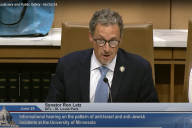You have /5 articles left.
Sign up for a free account or log in.
A year ago, when the rate at which borrowers defaulted on their student loans rose for only the second time since a unified campaign began in 1992 to bring the rate down, some observers speculated that the uptick portended a trend that could be exacerbated by mounting student debt and rising interest rates on many student loans.
They appear to have been wrong.
The U.S. Education Department announced Monday that 4.6 percent of borrowers who began repaying their loans between October 1, 2004, and September 30, 2005 had defaulted on those loans by September 2006, down from 5.1 percent the previous year.
Department officials attributed the decline in part to the large numbers of students who consolidated multiple student loans into one, taking advantage of a last-ditch opportunity to lock in their interest rates (often lowering their monthly payments and extending repayment) before July 1, 2005, when interest rates on consolidated loans rose.
The decrease was credited to another exceptional factor as well: the repayment relief that the federal government granted to college students and their families who were affected by Hurricanes Katrina and Rita in fall 2005. The Education Department gave affected borrowers six months of forbearance on their student loans, and deferments to those who qualified for economic hardship and job loss.
Over all, default rates peaked at 22.4 percent in 1992, and have fallen sharply and relatively consistently since then.
The 2005 rates fell from 2004 in every category of institution but two -- for-profit colleges and private colleges that provided less than two years of education, both of which stayed flat. Over all, as seen in the more-detailed table below, default rates for borrowers from public institutions fell to 4.3 percent from 4.7 percent; for for public institutions rose to 4.7 percent from 4.3 percent (two-year public colleges saw their rate fall to 7.9 percent from 8.1 percent from 7.6 percent, and four-year colleges to 3.0 percent from 3.5 percent), and the rate for private four-year colleges dipped to 2.3 percent from 2.8 percent. The default rate for borrowers from for-profit colleges dropped to 8.2 percent in 2005 from 8.6 percent in 2004.
Cohort Default Rates from 2003 to 2005, by Type of Institution
| 2003 | 2004 | 2005 | ||||
| Institution Type | Default Rate | No. of Borrowers Entered Repayment | Default Rate | No. of Borrowers Entered Repayment | Default Rate | No. of Borrowers Entered Repayment |
| Public | 4.3% | 1,356,086 | 4.7% | 1,488,978 | 4.3% | 1,803,195 |
| Less than 2-year | 5.8% | 6,182 | 5.7% | 6,808 | 5.2% | 7,567 |
| 2-3-year | 7.6% | 328,730 | 8.1% | 386,474 | 7.9% | 463,007 |
| 4-year | 3.3% | 1,021,174 | 3.5% | 1,095,696 | 3.0% | 1,332,621 |
| Private | 2.8% | 695,576 | 3.0% | 741,372 | 2.4% | 950,819 |
| Less than 2-year | 7.9% | 3,326 | 9.0% | 3,881 | 9.0% | 4,434 |
| 2-3-year | 6.3% | 23,160 | 7.4% | 20,539 | 6.7% | 21,819 |
| 4-year | 2.6% | 669,090 | 2.8% | 716,952 | 2.3% | 924,566 |
| Proprietary | 7.3% | 493,895 | 8.6% | 588,432 | 8.2% | 730,385 |
| Less than 2-year | 7.9% | 117,166 | 8.9% | 130,810 | 8.9% | 141,953 |
| 2-3 year | 8.0% | 179,553 | 9.9% | 205,000 | 9.3% | 240,545 |
| 4-year | 6.4% | 197,176 | 7.3% | 252,622 | 7.2% | 347,887 |
| Foreign | 1.8% | 5,844 | 1.5% | 6,662 | 1.0% | 11,156 |
| Unclassified | 0.0% | 31 | 5.5% | 18 | 0.0% | 29 |
| Total | 4.5% | 2,551,432 | 5.1% | 2,825,462 | 4.6% | 3,495,584 |
Source: U.S. Education Department









